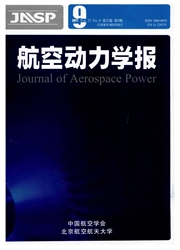

 中文摘要:
中文摘要:
为揭示某单级压气机非设计转速下影响效率和稳定性的关键因素,采用实验和数值模拟相结合的方法,系统地研究了该压气机动、静叶通道内的二次流动随工况(即叶片负荷)的变化规律.对于转子,大流量工况叶端区的二次流主要以泄漏流/泄漏涡和轮毂角区分离为主,而到了峰值效率和近失速工况,整个叶高基元的过度扩压导致的叶片失速抑制了轮毂角区失速的发生.静叶叶尖端区的二次流动虽然具有三维性,但到了近失速工况它依然没有发展成为角区失速.静叶叶根的泄漏流动虽然对端壁附面层的低能流体向轮毂吸力面角区的汇聚起到了一定的抑制作用,但它对角区失速的控制效果却受到压气机不同流量工况的影响.近失速工况叶根泄漏流动抑制角区失速的能力不足是导致压气机效率下降的主要因素,而转子叶尖的二次流动造成的对整个叶尖通道的阻塞是限制压气机稳定性的关键因素.
 英文摘要:
英文摘要:
To determine the key factors influencing the efficiency and stability of a subsonic axial flow compressor stage at off-design speed,experimental and numerical investigations were conducted to analyze the evolution of its secondary flow near the end-wall over a full stable operating range.The results show that a hub corner stall and a tip leakage flow dominate the endwall region of the rotor at a large mass flow condition.However,the fullspan blade stall due to the over-diffusion inhibite the hub corner stall at peak efficiency and near stall flow conditions.The flow separation in the corner region of the casing of the stator blade is three-dimensional,but don't evolve into a hub corner stall even at the near stall flow condition.The leakage flow of the stator near hub could decrease and energize the cross-flow due to the overturning of the fluid near the casing,thus inhibiting or mitigating the hub corner stall.However,the control effect is influenced by different flow conditions of the compressor.At the near stall condition,a decrease in the stage efficiency mainly comes from the fact that the leakage flow has not enough capability for suppressing the hub corner stall,while the compressor stage stability is limited by the flow blockage arising from the seconda-ry flow near the rotor tip.
 同期刊论文项目
同期刊论文项目
 同项目期刊论文
同项目期刊论文
 期刊信息
期刊信息
